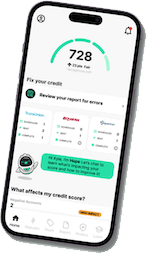A 500 credit score may feel limiting, but it’s not a life sentence. With the right approach, you can transform it into a stronger, healthier score that opens doors to better financial opportunities. In this blog, we’ll cover practical tips and long-term strategies to help you boost your score and maintain it for the future. Ready to take control of your credit journey? Let’s dive into the steps that can lead to financial freedom.
How Can You Improve a 500 Credit Score?

TL;DR: Watch the video below for all the tips and strategies on how to improve your 500 credit score instead!
A 500 credit score can feel like a financial handcuff, locking away opportunities for loans and credit cards. Understanding the impact of a low credit score is crucial for financial rehabilitation.
In the coming sections, we’ll outline actionable tips and long-term strategies to not just elevate your score but to sustain it.
Transforming a 500 credit score into a symbol of creditworthiness is a challenging but achievable mission. Read on to discover the steps you can take towards better financial health and freedom.
4 Tips to Improve Your Score
Improving a score that’s around the 500 mark requires good financial behavior and patience (learn more about how long it takes to fix a 500 credit score). A 500 score is likely the result of previous financial difficulties, but by following these four key strategies, you’ll be on your path to better credit health.
1. Pay Down Existing Debt
Reducing your outstanding debt is one of the fastest ways to improve your score. Focus on bringing down the balances, starting with the one with the highest rate. As you pay down your debts, your credit utilization ratio — the amount of credit you’re using compared to your credit limit — will decrease. This is a major factor that credit scoring models consider when determining your score.
Lowering your utilization rate shows lenders that you’re not overextending yourself and can manage credit well. Moreover, as you pay off the high-interest cards and move to the next ones, the credit you’re not using positively influences your score by showing unused credit availability.
2. Get Credit for Your Monthly Bills
Many people don’t realize that even regular, non-credit bill payments can positively impact their score. This is where services that regularly pay each month, like your rent, utilities and sometimes even subscription services are reported to the major credit bureaus; Experian, Equifax and TransUnion, aiding in your payment history.
If you consistently pay your monthly bills on time, this can be reflected in your credit history, demonstrating a reliable payment pattern. Make sure to enroll in any available service that reports these payments to the credit bureaus, thus contributing positively to your payment history and improving your score over time. Services that can assist in this are ExperianBoost and Boom.
3. Dispute any Errors on Your Report
Even the most diligent individuals can fall victim to errors on their reports. Incorrect information can drag down your score, not reflecting the true nature of your financial habits. According to the Fair Credit Reporting Act (FCRA), you have the right to dispute any errors you find on your report.
Promptly address mistakes by submitting a formal dispute letter to the credit bureau that has reported the incorrect information. The bureau typically has 30-45 days to investigate and resolve your dispute.
Removing these errors from your report can provide a significant boost to your score as it cleanses your report of any inaccuracies that may be unfairly lowering your score.
4. Build Credit
If your score is suffering because you don’t have enough credit, it may be time to consider building credit. Here are two ways to do so:
- Apply for a secured credit card: Consider getting a secured credit card. Make sure to use the card responsibly and pay your balance in full each month to avoid interest charges.
- Consider a credit-builder loan: Look into getting a credit-builder loan, not to be confused with a personal loan, which can help you establish a positive payment.
How is a Credit Score Calculated?
Understanding how your score is calculated can help you develop a strategy to improve it beyond the 4 tips listed above. While different credit scoring models may have slight variations, the FICO scoring model is widely used and provides a general guideline for score calculations. You can read more about how scores are calculated here.
FICO takes into account several factors to determine your t score. These factors include:
- Payment History: This factor has the most significant impact on your t score. It assesses whether you have a history of making on time payments or if you have any late payments, defaults, or bankruptcies.
- Credit Utilization: As mentioned earlier, your credit utilization ratio plays an essential role in determining your score. It considers the amount of credit you are currently using compared to your total available credit limit. A lower utilization rate indicates responsible credit management.
- Length of Credit History: The length of time you’ve had credit accounts impacts your score. Generally, a longer credit history can be beneficial as it provides more information for lenders to assess your creditworthiness.
- Credit Mix: The types of credit you have, such as credit cards, loans, and mortgages, are taken into account. Having a mix of credit accounts can demonstrate your ability to handle
- New Credit: Opening multiple new credit accounts within a short period can raise concerns for lenders. It may indicate a higher risk of default or an increased likelihood of relying heavily on credit. When you apply for new credit, lenders typically perform a hard inquiry on your report, which can temporarily lower your score.
What is Considered a Good Credit Score?
A good score is an indicator of financial reliability and is essential for securing favorable loan terms. Scores are numerical summaries of your credit history, with a range from 300 to 850. A score of 700 or above is generally considered good and reflects responsible credit management and a stable financial history. Being in this range increases your chances of loan and credit card approvals at competitive interest rates.
Here’s a quick breakdown of score classifications:
Score Range | Classification |
|---|---|
740 – 850 | Very Good to Excellent |
700 – 739 | Good |
580 – 699 | Fair |
300 – 579 | Poor |
Scores between 580 and 669 are deemed fair, which is below the preferred range. A very good to excellent score falls between 740 to 850, showcasing a low-risk credit profile that attracts the best interest rates and high credit limits. Maintaining a good score is crucial for your financial profile, as it shapes the lending options and credit facilities available to you. If you don’t know where to start, follow our blueprint to improve your credit score from 500 to 700!
How to Maintain a Good Credit Score
Maintaining a good score is akin to taking care of your physical health – it requires consistency, discipline, and an understanding of what affects it. Just like regular exercise and a balanced diet contribute to your wellbeing, developing and sticking to positive financial behaviors is crucial for preserving and improving your credit standing. Here are three tips to maintain a good score.
1. Make Payments on Time
One of the most significant factors in credit scoring is your payment history, which can determine as much as 35 percent of your score according to FICO. To put it into perspective, this means that every payment you make—or miss—can have a substantial impact. Timely payments boost your credit reputation, demonstrating to creditors and lenders your reliability in managing debt.
Given its predominant effect on your score, avoiding late payments should be a top priority. Consider setting up automatic payments for recurring bills like mortgages, credit cards, and loans. This simple automation aids you in remembering due dates, ensuring that payments are consistently made on time, and thus deters the chance of accidental slip-ups that could scar your credit report.
2. Keep Your Credit Utilization Ratio Low
Picture your credit limit as a financial health barometer—staying far below its maximum is indicative of well-managed debt and fiscal prudence. A low credit utilization ratio is appealing to lenders, signifying that you’re not over-dependent on credit and you manage your finances well. For a healthier score, aim to keep this ratio below 30 percent.
Accomplishing a favorable utilization ratio involves a blend of paying down existing debt and avoiding high balances on your credit cards. If possible, becoming an authorized user on a responsible holder’s account with a long history of low utilization can also contribute to lowering your overall ratio.
3. Monitor Your Report and Score
Regular scrutiny of your credit profile is a critical stride in securing a better credit future. It’s like getting a regular health check-up: monitoring reveals the state of your financial health, directing you toward aspects that need improvement. By examining your credit report consistently, you can uncover any inaccuracies or fraudulent activities that could unfairly pull down your score. You are entitled to one free credit report with each bureau, every 12 months. You can access your reports for free through annualcreditreport.com.
Furthermore, various credit counseling services can offer assistance if your credit repair journey seems overwhelming. Remember, vigilance in monitoring your credit is central during this period of improvement.
Dovly AI is an advanced credit engine that can assist you in improving your 500 credit score and then helping you maintain your score once it’s increased. Dovly AI offers services designed to track, manage and fix your credit. Enroll today for free and receive a monthly TransUnion credit report and score!
Related Blog Posts
Frequently Asked Questions

Tedis Baboumian
Tedis Baboumian is Dovly’s Co-Founder and Chief Credit Officer. With over 20 years of experience in the consumer credit industry, Tedis is an authority on the credit industry and has cultivated deep… Read More




